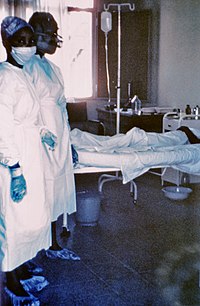
Photo from wikipedia
Liver diseases seriously challenge the health of chickens raised on scaled farms and cause tremendous economic losses to farm owners. The causative agents for liver diseases are still elusive, even… Click to show full abstract
Liver diseases seriously challenge the health of chickens raised on scaled farms and cause tremendous economic losses to farm owners. The causative agents for liver diseases are still elusive, even though various pathogens, such as the hepatitis E virus, have been reported. In the winter of 2021, a liver disease was observed on a chicken farm in Dalian, China, which increased chicken mortality by up to 18%. We conducted panvirome profiling of the livers, spleens, kidneys, and recta of 20 diseased chickens. The viromic results revealed coinfection of multiple viruses, including pathogenic ones, in these organs. The viruses were highly identical to those detected in other provinces, and the vaccine and field strains of avian encephalomyelitis virus (AEV) and chicken infectious anemia virus (CIAV) cocirculated on the farm. In particular, the liver showed higher abundance of AEV and multiple fowl adenoviruses than other organs. Furthermore, the liver also contracted avian leukemia virus and CIAV. Experimental animals with infected liver samples developed minor to medium lesions of the liver and showed a virus abundance profile for AEV across internal organs similar to that in the original samples. These results suggest that coinfection with multiple pathogenic viruses influences the occurrence and development of infectious liver disease. The results also highlight that strong farm management standards with strict biosafety measures are needed to minimize the risk of pathogenic virus introduction to the farm.
Journal Title: Viruses
Year Published: 2023
Link to full text (if available)
Share on Social Media: Sign Up to like & get
recommendations!